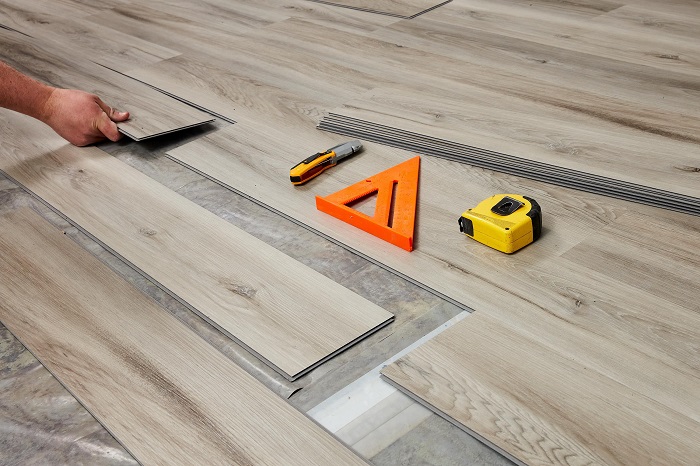
Waterproof qualities have been added to the popular laminate floors you know and love. Waterproof and water-resistant laminate flooring is now available, making this classic wood-look floor even more appealing.
Now you may use this low-cost flooring in additional rooms of the house, such as the kitchen or bathroom, knowing that it will stand up to the rigours of daily life.
Continue reading to discover more about how waterproof and water-resistant laminate flooring works, what to expect, and how to pick the best option for your needs.
Waterproof laminate is a more water-resistant version of the popular wood-look synthetic floor. Laminate has a realistic appearance and may easily be mistaken for real wood. Laminate is popular because to its inexpensive price, however it has never been noted for its water resistance.
That is, until now! New waterproof elements in laminate flooring are proven to be game-changers. Laminate has a reputation for absorbing water and swelling rapidly. But, thanks to cutting-edge technology, that has all changed.
Multiple layers make up waterproof and water-resistant laminate flooring, including:
The top layer provides an authentic look and feels to the floor while protecting it from scratches, wear, and discolouration. This is the floor's protective shield, which prevents the dog's clattering claws from making markings. A waterproof seal prevents water from penetrating the floor and causing damage.
The image layer, which is just below the wear layer, contains the pattern or print of your floor. This provides your base with a stunning and authentic wood or stone appearance plank.
The core layer lies beneath the print layer and provides the floor with longevity and stability. This layer, which comprises compressed high-density fiberboard (HDF), is where the water-resistant or waterproof properties kick in. Water-resistant laminate floors may have more resins in the fiberboard, making them less prone to swelling in water.
This layer also aids in floor stability and prevents water from infiltrating the flooring below. Backing layers are frequently used to assist protect the core from subfloor dampness such as that found in concrete floors or basements, ensuring that each plank is resistant to moisture from above and below.
What is the main difference between the terms "waterproof" and "water-resistant" as used by some companies to describe their products?
When it comes to flooring, waterproof and water-resistant are not the same.
These definitions may differ from one manufacturer to the next. To be assured of a product's level of water resistance, read the descriptions of the laminate floors you're considering carefully. Proper installation of waterproof laminate is sometimes required to ensure that water does not infiltrate the core and cause swelling.
It's also feasible to improve the water-resistance of your laminate floor while it's being installed. Some manufacturers recommend finishing the laminate floor installation with silicone sealant around the perimeter and under the baseboard for added water protection.
However, they should be treated cautiously because waterproof and water-resistant laminate flooring is not built the same as other waterproof floors. Waterproof laminate, unlike vinyl, cannot be entirely submerged in water because it is still made of wood.
Water-resistant laminate flooring is usually water-resistant from top to bottom, but not always. This implies that if your floor gets wet or has a spill, waterproof or water-resistant floor systems will prevent liquids from seeping through the interlocks, preventing mould or mildew from growing beneath your flooring. However, if your subfloor has moisture issues, you'll still require a vapour barrier for waterproof laminate floors.
Luxury vinyl flooring comprises synthetic materials and is moisture resistant, which means it may be submerged and will not absorb any water. If your subfloor has moisture issues, the manufacturer will almost certainly require you to install your laminate with a vapour barrier to maintain your warranty.
Because laminate flooring is already the go-to wood-look flooring option, the up-and-coming waterproof goods are expected to make a stir in the flooring market. The following are some of the reasons why homeowners and business owners should choose waterproof laminate flooring:
Waterproof laminate flooring is making an impact in the flooring market. Laminate flooring is currently the go-to wood-look flooring option. Here are some reasons homeowners and business owners should choose waterproof laminate flooring.
Waterproof Laminate Flooring Benefits
I know you're rooting for this floor right now, but what good is a guide if it doesn't warn you about the drawbacks? Every floor has its own set of issues. The following are some of the disadvantages of laminate flooring:
Waterproof vinyl flooring is more water-resistant: While laminate flooring has come a long way in terms of water resistance, it still can't stand up to standing water. The water-resistance of laminate, unlike vinyl, works from top to bottom rather than bottom to top. Even if your subfloor has moisture concerns, you'll need a vapour barrier.
Sound: Laminate floors can make a hollow, empty sound when laid on an uneven surface without an underlayment. Every product comes with detailed installation instructions, including how to prepare your flooring area, and if you're still concerned, you can always contact a professional.
 Call Now
Call Now